Interaction of Cryptography and Economics
VerifiedAdded on 2023/04/04
|14
|1839
|390
AI Summary
The interaction between cryptography and economics can be referred to as crypto economics. The process of ultimately securing a network from parties who can listen and control the channel is referred to as cryptography.
Contribute Materials
Your contribution can guide someone’s learning journey. Share your
documents today.

1
NB: The data set used is obtained from yahoo finance, historical data from January 31 2018 to January
31 2019.
(Q1)
Interaction of Cryptography and Economics
In a decentralized system, access is limited parties involved with interacting with the system. Bad
actors will always try to disrupt and gain access to the system. The approaches of cryptography and
economics aim to establish a decentralized network can thrive besides attempt to disruption. The
underlying concepts that make the P2P network communication secure between the parties are the
cryptography while economics is the aspect that motivates the actors to contribute to the network to
ensure its continuity.
Economics provides a layer of abstraction that ensures coordination and interaction between the
network participants in the decentralized cryptographic system. The interaction between cryptography
and economics can be referred to as crypto economics. The process of ultimately securing a network
from parties who can listen and control the channel is referred to as cryptography.
Understanding Block chain technology
This refers to a list of records that are linked together using the concepts of cryptography. Each of the
consecutive blocks of record contains a timestamp and a cryptographic hash from the previous block.
The blocks can be used to store information between two parties and the transactions involved by the
parties using a digital signature. Records that are captured using block chain are verified in a way such
that the records cannot be altered.
The invention of the block chain was meant to act as a decentralized public ledger that can manage
transactions using the cryptocurrencies. Block chain enables participants to alter and audit the
transactions independently.
Participating not involved in the communication can be able to alter the data without changing the
subsequent blocks. The block chain network has no central authority since it shared. Hence any
infrastructure built on block chain is transparent, and the parties are responsible for every transaction.
NB: The data set used is obtained from yahoo finance, historical data from January 31 2018 to January
31 2019.
(Q1)
Interaction of Cryptography and Economics
In a decentralized system, access is limited parties involved with interacting with the system. Bad
actors will always try to disrupt and gain access to the system. The approaches of cryptography and
economics aim to establish a decentralized network can thrive besides attempt to disruption. The
underlying concepts that make the P2P network communication secure between the parties are the
cryptography while economics is the aspect that motivates the actors to contribute to the network to
ensure its continuity.
Economics provides a layer of abstraction that ensures coordination and interaction between the
network participants in the decentralized cryptographic system. The interaction between cryptography
and economics can be referred to as crypto economics. The process of ultimately securing a network
from parties who can listen and control the channel is referred to as cryptography.
Understanding Block chain technology
This refers to a list of records that are linked together using the concepts of cryptography. Each of the
consecutive blocks of record contains a timestamp and a cryptographic hash from the previous block.
The blocks can be used to store information between two parties and the transactions involved by the
parties using a digital signature. Records that are captured using block chain are verified in a way such
that the records cannot be altered.
The invention of the block chain was meant to act as a decentralized public ledger that can manage
transactions using the cryptocurrencies. Block chain enables participants to alter and audit the
transactions independently.
Participating not involved in the communication can be able to alter the data without changing the
subsequent blocks. The block chain network has no central authority since it shared. Hence any
infrastructure built on block chain is transparent, and the parties are responsible for every transaction.
Secure Best Marks with AI Grader
Need help grading? Try our AI Grader for instant feedback on your assignments.
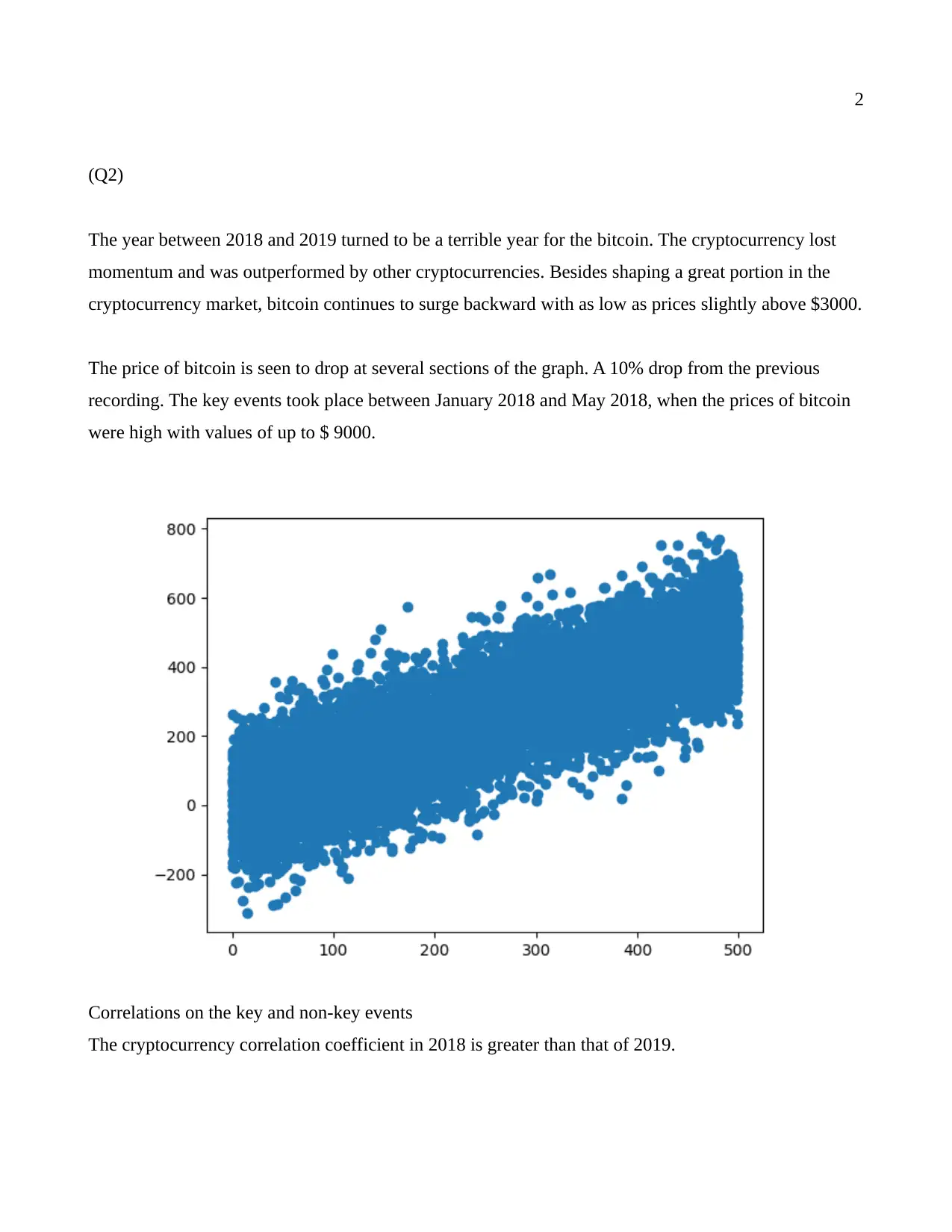
2
(Q2)
The year between 2018 and 2019 turned to be a terrible year for the bitcoin. The cryptocurrency lost
momentum and was outperformed by other cryptocurrencies. Besides shaping a great portion in the
cryptocurrency market, bitcoin continues to surge backward with as low as prices slightly above $3000.
The price of bitcoin is seen to drop at several sections of the graph. A 10% drop from the previous
recording. The key events took place between January 2018 and May 2018, when the prices of bitcoin
were high with values of up to $ 9000.
Correlations on the key and non-key events
The cryptocurrency correlation coefficient in 2018 is greater than that of 2019.
(Q2)
The year between 2018 and 2019 turned to be a terrible year for the bitcoin. The cryptocurrency lost
momentum and was outperformed by other cryptocurrencies. Besides shaping a great portion in the
cryptocurrency market, bitcoin continues to surge backward with as low as prices slightly above $3000.
The price of bitcoin is seen to drop at several sections of the graph. A 10% drop from the previous
recording. The key events took place between January 2018 and May 2018, when the prices of bitcoin
were high with values of up to $ 9000.
Correlations on the key and non-key events
The cryptocurrency correlation coefficient in 2018 is greater than that of 2019.
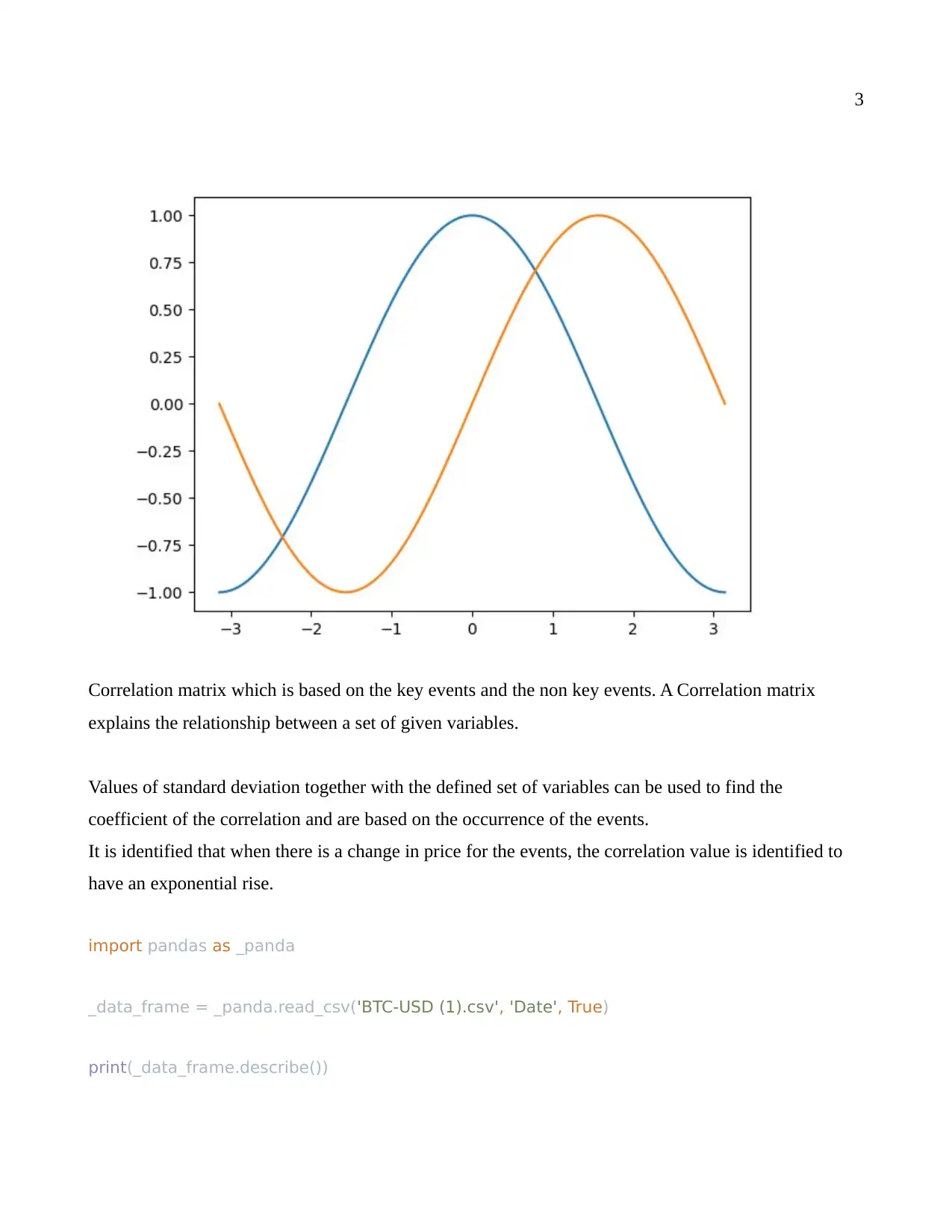
3
Correlation matrix which is based on the key events and the non key events. A Correlation matrix
explains the relationship between a set of given variables.
Values of standard deviation together with the defined set of variables can be used to find the
coefficient of the correlation and are based on the occurrence of the events.
It is identified that when there is a change in price for the events, the correlation value is identified to
have an exponential rise.
import pandas as _panda
_data_frame = _panda.read_csv('BTC-USD (1).csv', 'Date', True)
print(_data_frame.describe())
Correlation matrix which is based on the key events and the non key events. A Correlation matrix
explains the relationship between a set of given variables.
Values of standard deviation together with the defined set of variables can be used to find the
coefficient of the correlation and are based on the occurrence of the events.
It is identified that when there is a change in price for the events, the correlation value is identified to
have an exponential rise.
import pandas as _panda
_data_frame = _panda.read_csv('BTC-USD (1).csv', 'Date', True)
print(_data_frame.describe())
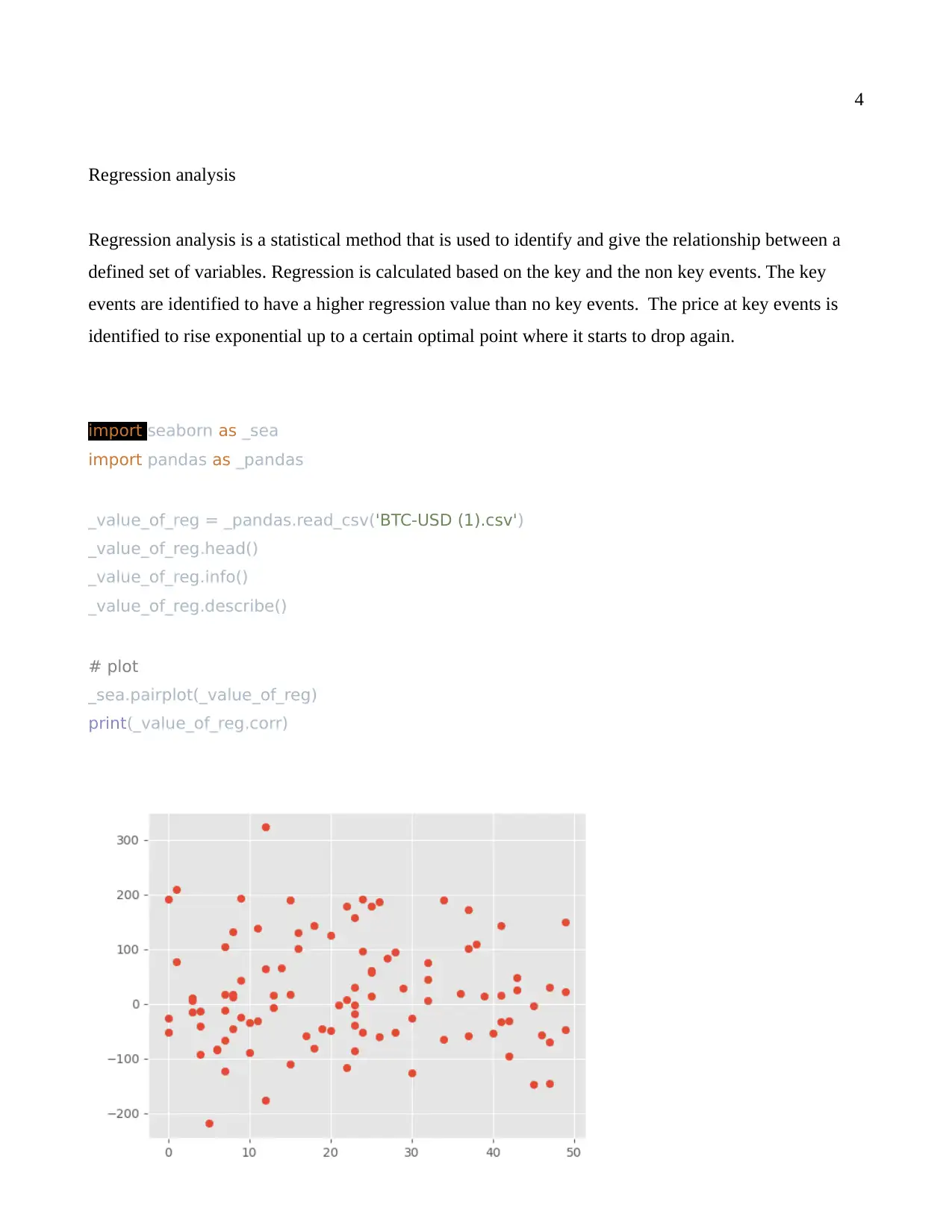
4
Regression analysis
Regression analysis is a statistical method that is used to identify and give the relationship between a
defined set of variables. Regression is calculated based on the key and the non key events. The key
events are identified to have a higher regression value than no key events. The price at key events is
identified to rise exponential up to a certain optimal point where it starts to drop again.
import seaborn as _sea
import pandas as _pandas
_value_of_reg = _pandas.read_csv('BTC-USD (1).csv')
_value_of_reg.head()
_value_of_reg.info()
_value_of_reg.describe()
# plot
_sea.pairplot(_value_of_reg)
print(_value_of_reg.corr)
Regression analysis
Regression analysis is a statistical method that is used to identify and give the relationship between a
defined set of variables. Regression is calculated based on the key and the non key events. The key
events are identified to have a higher regression value than no key events. The price at key events is
identified to rise exponential up to a certain optimal point where it starts to drop again.
import seaborn as _sea
import pandas as _pandas
_value_of_reg = _pandas.read_csv('BTC-USD (1).csv')
_value_of_reg.head()
_value_of_reg.info()
_value_of_reg.describe()
# plot
_sea.pairplot(_value_of_reg)
print(_value_of_reg.corr)
Secure Best Marks with AI Grader
Need help grading? Try our AI Grader for instant feedback on your assignments.
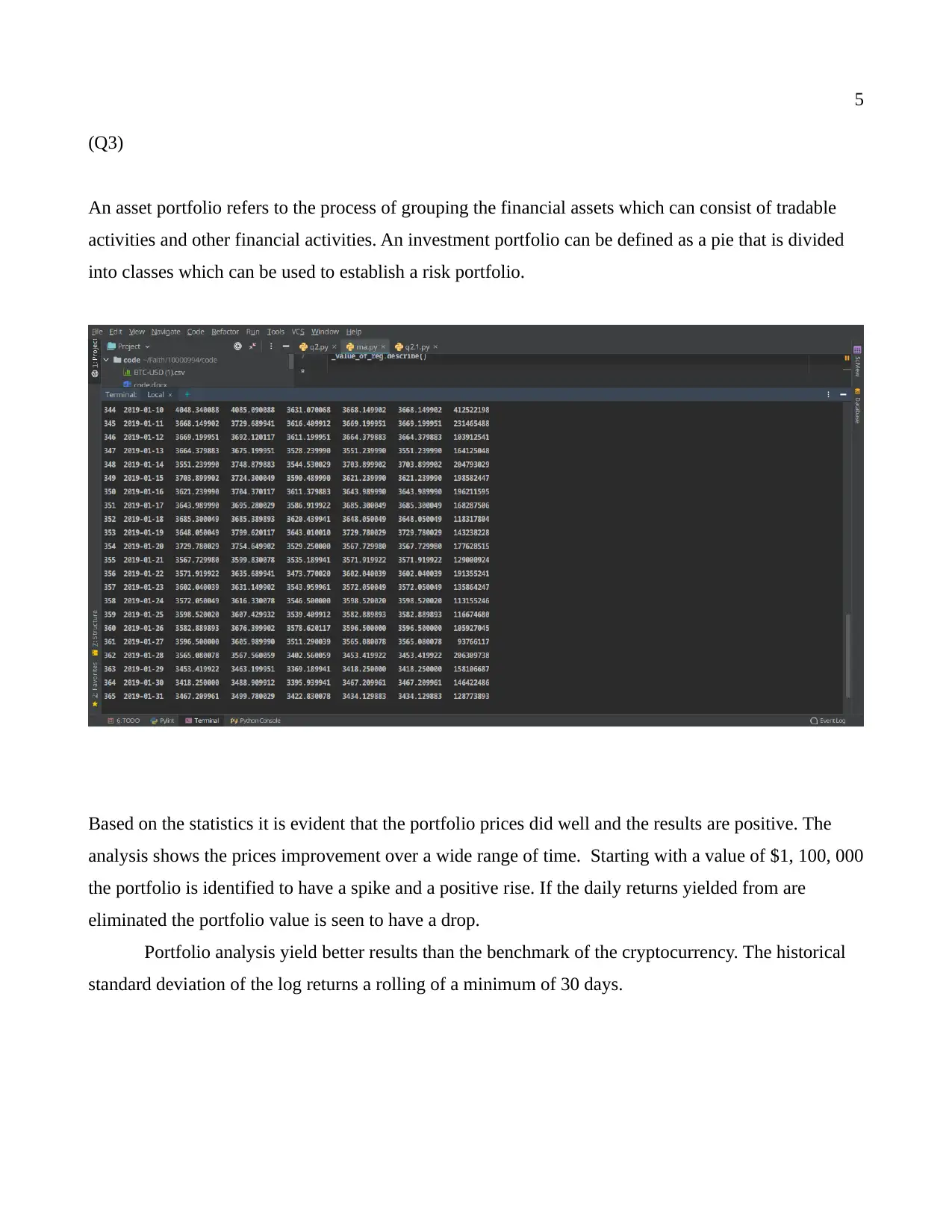
5
(Q3)
An asset portfolio refers to the process of grouping the financial assets which can consist of tradable
activities and other financial activities. An investment portfolio can be defined as a pie that is divided
into classes which can be used to establish a risk portfolio.
Based on the statistics it is evident that the portfolio prices did well and the results are positive. The
analysis shows the prices improvement over a wide range of time. Starting with a value of $1, 100, 000
the portfolio is identified to have a spike and a positive rise. If the daily returns yielded from are
eliminated the portfolio value is seen to have a drop.
Portfolio analysis yield better results than the benchmark of the cryptocurrency. The historical
standard deviation of the log returns a rolling of a minimum of 30 days.
(Q3)
An asset portfolio refers to the process of grouping the financial assets which can consist of tradable
activities and other financial activities. An investment portfolio can be defined as a pie that is divided
into classes which can be used to establish a risk portfolio.
Based on the statistics it is evident that the portfolio prices did well and the results are positive. The
analysis shows the prices improvement over a wide range of time. Starting with a value of $1, 100, 000
the portfolio is identified to have a spike and a positive rise. If the daily returns yielded from are
eliminated the portfolio value is seen to have a drop.
Portfolio analysis yield better results than the benchmark of the cryptocurrency. The historical
standard deviation of the log returns a rolling of a minimum of 30 days.
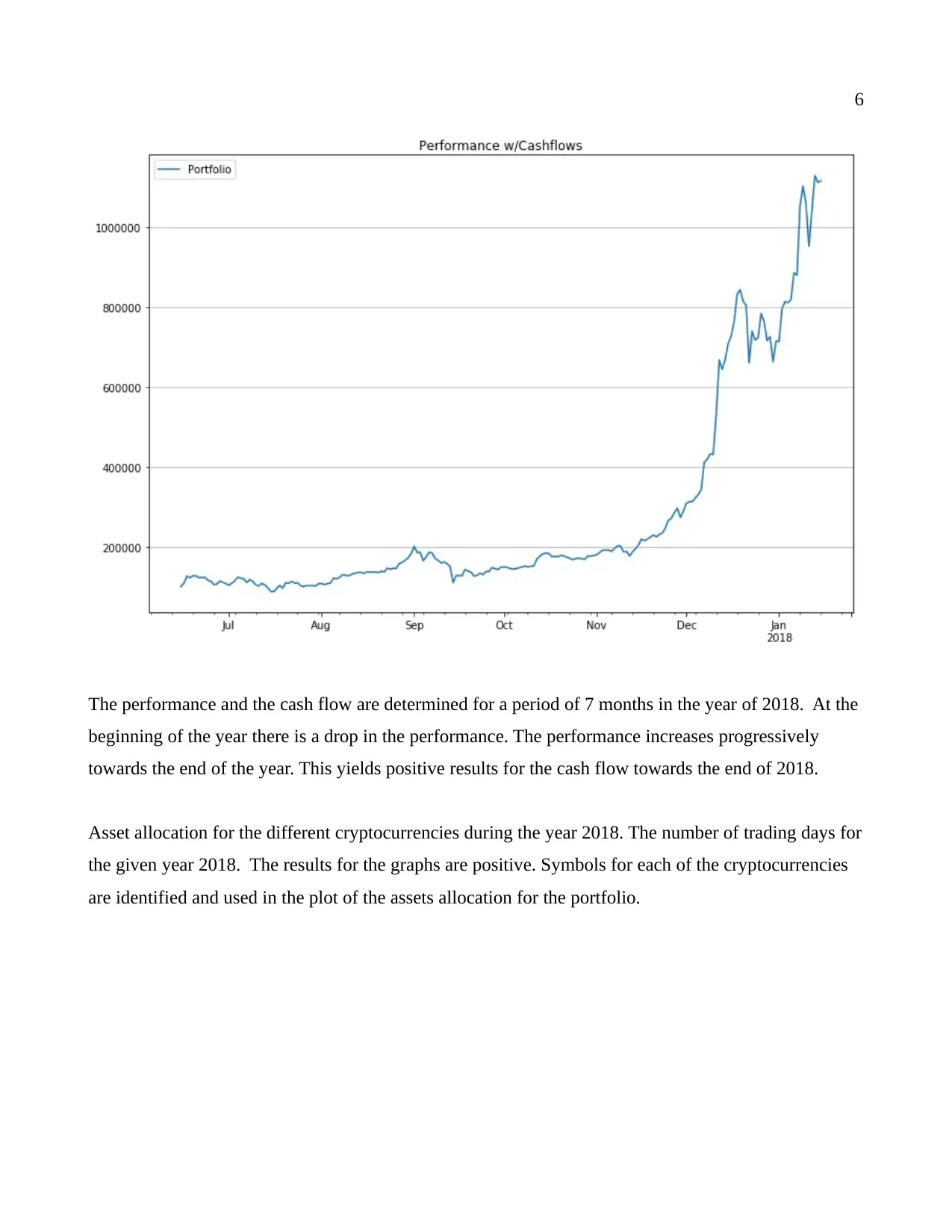
6
The performance and the cash flow are determined for a period of 7 months in the year of 2018. At the
beginning of the year there is a drop in the performance. The performance increases progressively
towards the end of the year. This yields positive results for the cash flow towards the end of 2018.
Asset allocation for the different cryptocurrencies during the year 2018. The number of trading days for
the given year 2018. The results for the graphs are positive. Symbols for each of the cryptocurrencies
are identified and used in the plot of the assets allocation for the portfolio.
The performance and the cash flow are determined for a period of 7 months in the year of 2018. At the
beginning of the year there is a drop in the performance. The performance increases progressively
towards the end of the year. This yields positive results for the cash flow towards the end of 2018.
Asset allocation for the different cryptocurrencies during the year 2018. The number of trading days for
the given year 2018. The results for the graphs are positive. Symbols for each of the cryptocurrencies
are identified and used in the plot of the assets allocation for the portfolio.
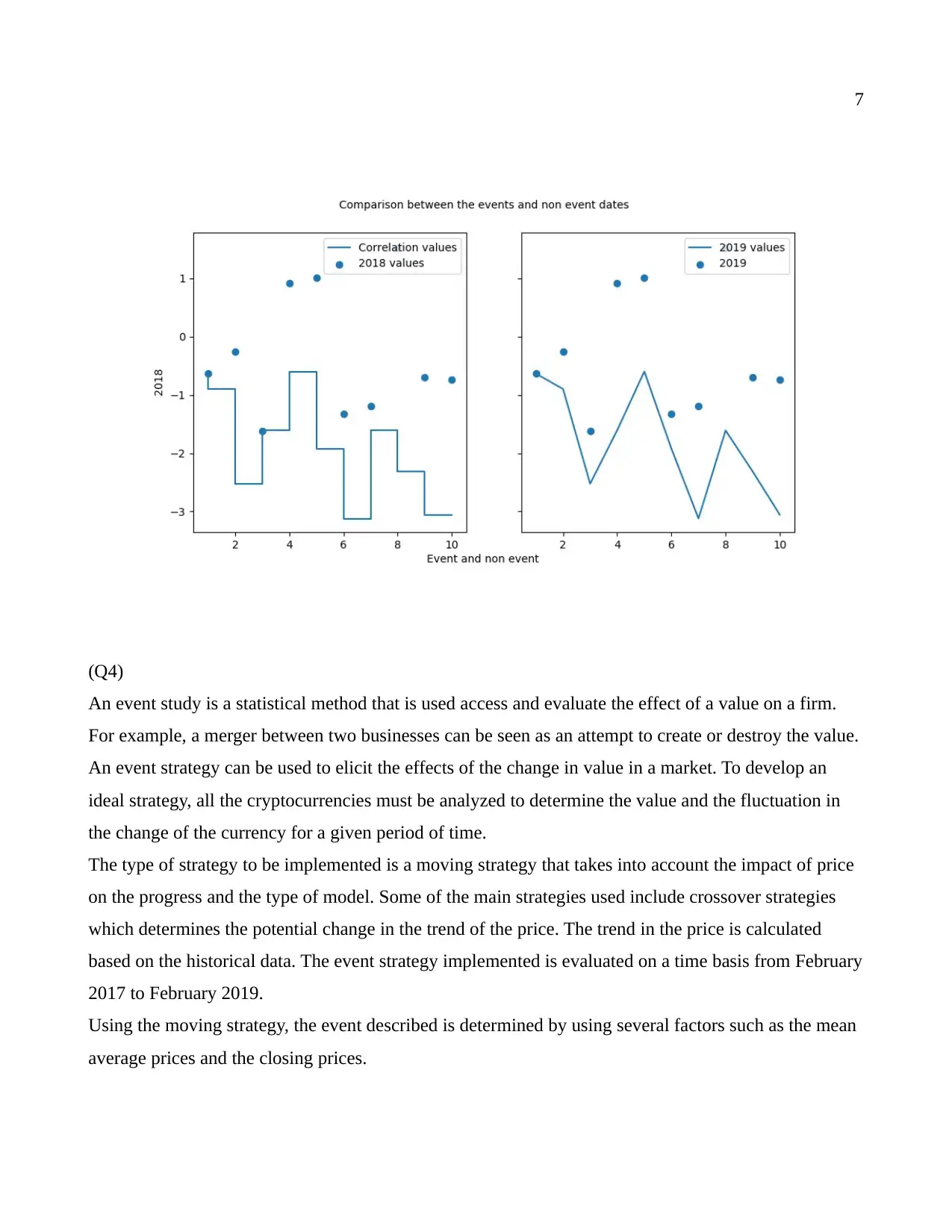
7
(Q4)
An event study is a statistical method that is used access and evaluate the effect of a value on a firm.
For example, a merger between two businesses can be seen as an attempt to create or destroy the value.
An event strategy can be used to elicit the effects of the change in value in a market. To develop an
ideal strategy, all the cryptocurrencies must be analyzed to determine the value and the fluctuation in
the change of the currency for a given period of time.
The type of strategy to be implemented is a moving strategy that takes into account the impact of price
on the progress and the type of model. Some of the main strategies used include crossover strategies
which determines the potential change in the trend of the price. The trend in the price is calculated
based on the historical data. The event strategy implemented is evaluated on a time basis from February
2017 to February 2019.
Using the moving strategy, the event described is determined by using several factors such as the mean
average prices and the closing prices.
(Q4)
An event study is a statistical method that is used access and evaluate the effect of a value on a firm.
For example, a merger between two businesses can be seen as an attempt to create or destroy the value.
An event strategy can be used to elicit the effects of the change in value in a market. To develop an
ideal strategy, all the cryptocurrencies must be analyzed to determine the value and the fluctuation in
the change of the currency for a given period of time.
The type of strategy to be implemented is a moving strategy that takes into account the impact of price
on the progress and the type of model. Some of the main strategies used include crossover strategies
which determines the potential change in the trend of the price. The trend in the price is calculated
based on the historical data. The event strategy implemented is evaluated on a time basis from February
2017 to February 2019.
Using the moving strategy, the event described is determined by using several factors such as the mean
average prices and the closing prices.
Paraphrase This Document
Need a fresh take? Get an instant paraphrase of this document with our AI Paraphraser
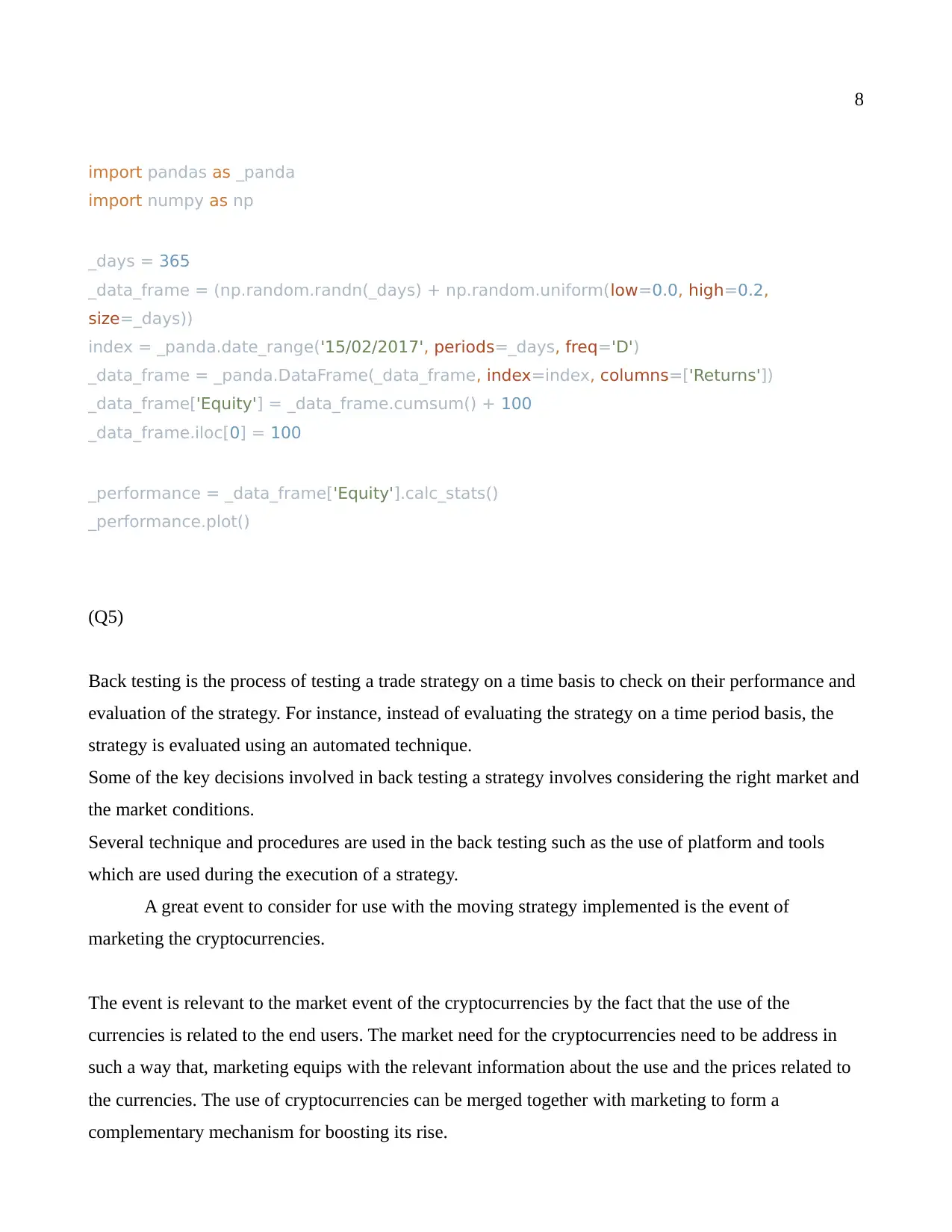
8
import pandas as _panda
import numpy as np
_days = 365
_data_frame = (np.random.randn(_days) + np.random.uniform(low=0.0, high=0.2,
size=_days))
index = _panda.date_range('15/02/2017', periods=_days, freq='D')
_data_frame = _panda.DataFrame(_data_frame, index=index, columns=['Returns'])
_data_frame['Equity'] = _data_frame.cumsum() + 100
_data_frame.iloc[0] = 100
_performance = _data_frame['Equity'].calc_stats()
_performance.plot()
(Q5)
Back testing is the process of testing a trade strategy on a time basis to check on their performance and
evaluation of the strategy. For instance, instead of evaluating the strategy on a time period basis, the
strategy is evaluated using an automated technique.
Some of the key decisions involved in back testing a strategy involves considering the right market and
the market conditions.
Several technique and procedures are used in the back testing such as the use of platform and tools
which are used during the execution of a strategy.
A great event to consider for use with the moving strategy implemented is the event of
marketing the cryptocurrencies.
The event is relevant to the market event of the cryptocurrencies by the fact that the use of the
currencies is related to the end users. The market need for the cryptocurrencies need to be address in
such a way that, marketing equips with the relevant information about the use and the prices related to
the currencies. The use of cryptocurrencies can be merged together with marketing to form a
complementary mechanism for boosting its rise.
import pandas as _panda
import numpy as np
_days = 365
_data_frame = (np.random.randn(_days) + np.random.uniform(low=0.0, high=0.2,
size=_days))
index = _panda.date_range('15/02/2017', periods=_days, freq='D')
_data_frame = _panda.DataFrame(_data_frame, index=index, columns=['Returns'])
_data_frame['Equity'] = _data_frame.cumsum() + 100
_data_frame.iloc[0] = 100
_performance = _data_frame['Equity'].calc_stats()
_performance.plot()
(Q5)
Back testing is the process of testing a trade strategy on a time basis to check on their performance and
evaluation of the strategy. For instance, instead of evaluating the strategy on a time period basis, the
strategy is evaluated using an automated technique.
Some of the key decisions involved in back testing a strategy involves considering the right market and
the market conditions.
Several technique and procedures are used in the back testing such as the use of platform and tools
which are used during the execution of a strategy.
A great event to consider for use with the moving strategy implemented is the event of
marketing the cryptocurrencies.
The event is relevant to the market event of the cryptocurrencies by the fact that the use of the
currencies is related to the end users. The market need for the cryptocurrencies need to be address in
such a way that, marketing equips with the relevant information about the use and the prices related to
the currencies. The use of cryptocurrencies can be merged together with marketing to form a
complementary mechanism for boosting its rise.
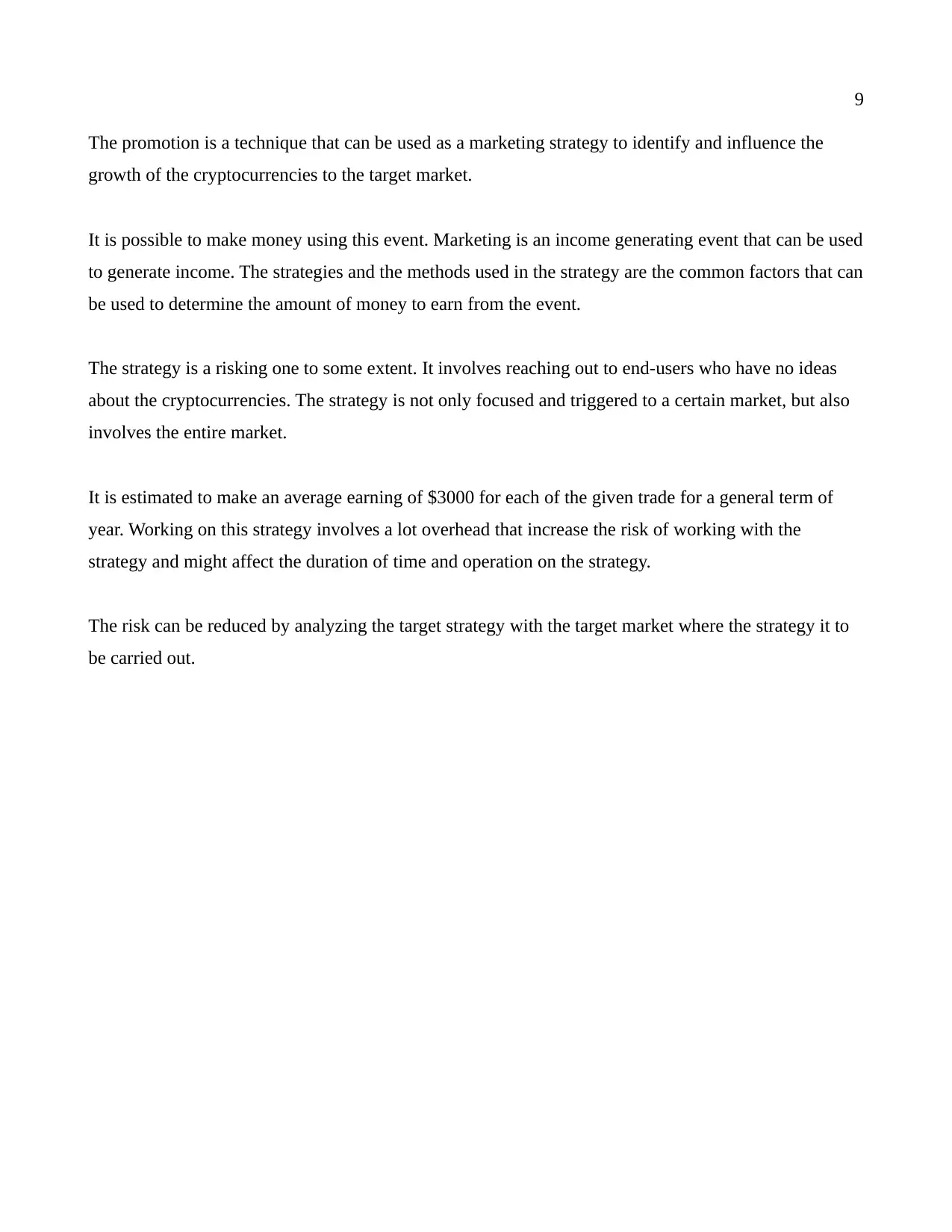
9
The promotion is a technique that can be used as a marketing strategy to identify and influence the
growth of the cryptocurrencies to the target market.
It is possible to make money using this event. Marketing is an income generating event that can be used
to generate income. The strategies and the methods used in the strategy are the common factors that can
be used to determine the amount of money to earn from the event.
The strategy is a risking one to some extent. It involves reaching out to end-users who have no ideas
about the cryptocurrencies. The strategy is not only focused and triggered to a certain market, but also
involves the entire market.
It is estimated to make an average earning of $3000 for each of the given trade for a general term of
year. Working on this strategy involves a lot overhead that increase the risk of working with the
strategy and might affect the duration of time and operation on the strategy.
The risk can be reduced by analyzing the target strategy with the target market where the strategy it to
be carried out.
The promotion is a technique that can be used as a marketing strategy to identify and influence the
growth of the cryptocurrencies to the target market.
It is possible to make money using this event. Marketing is an income generating event that can be used
to generate income. The strategies and the methods used in the strategy are the common factors that can
be used to determine the amount of money to earn from the event.
The strategy is a risking one to some extent. It involves reaching out to end-users who have no ideas
about the cryptocurrencies. The strategy is not only focused and triggered to a certain market, but also
involves the entire market.
It is estimated to make an average earning of $3000 for each of the given trade for a general term of
year. Working on this strategy involves a lot overhead that increase the risk of working with the
strategy and might affect the duration of time and operation on the strategy.
The risk can be reduced by analyzing the target strategy with the target market where the strategy it to
be carried out.
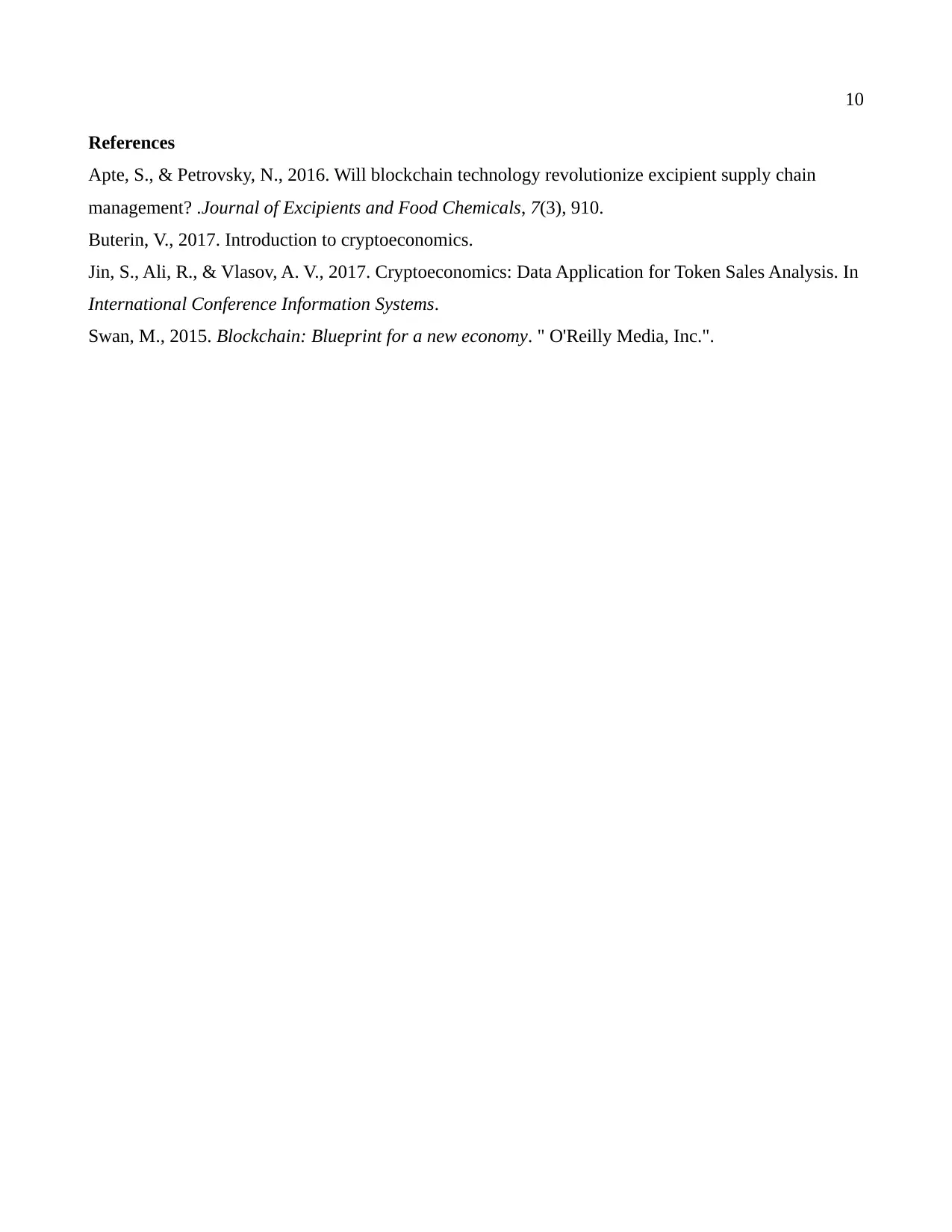
10
References
Apte, S., & Petrovsky, N., 2016. Will blockchain technology revolutionize excipient supply chain
management? .Journal of Excipients and Food Chemicals, 7(3), 910.
Buterin, V., 2017. Introduction to cryptoeconomics.
Jin, S., Ali, R., & Vlasov, A. V., 2017. Cryptoeconomics: Data Application for Token Sales Analysis. In
International Conference Information Systems.
Swan, M., 2015. Blockchain: Blueprint for a new economy. " O'Reilly Media, Inc.".
References
Apte, S., & Petrovsky, N., 2016. Will blockchain technology revolutionize excipient supply chain
management? .Journal of Excipients and Food Chemicals, 7(3), 910.
Buterin, V., 2017. Introduction to cryptoeconomics.
Jin, S., Ali, R., & Vlasov, A. V., 2017. Cryptoeconomics: Data Application for Token Sales Analysis. In
International Conference Information Systems.
Swan, M., 2015. Blockchain: Blueprint for a new economy. " O'Reilly Media, Inc.".
Secure Best Marks with AI Grader
Need help grading? Try our AI Grader for instant feedback on your assignments.
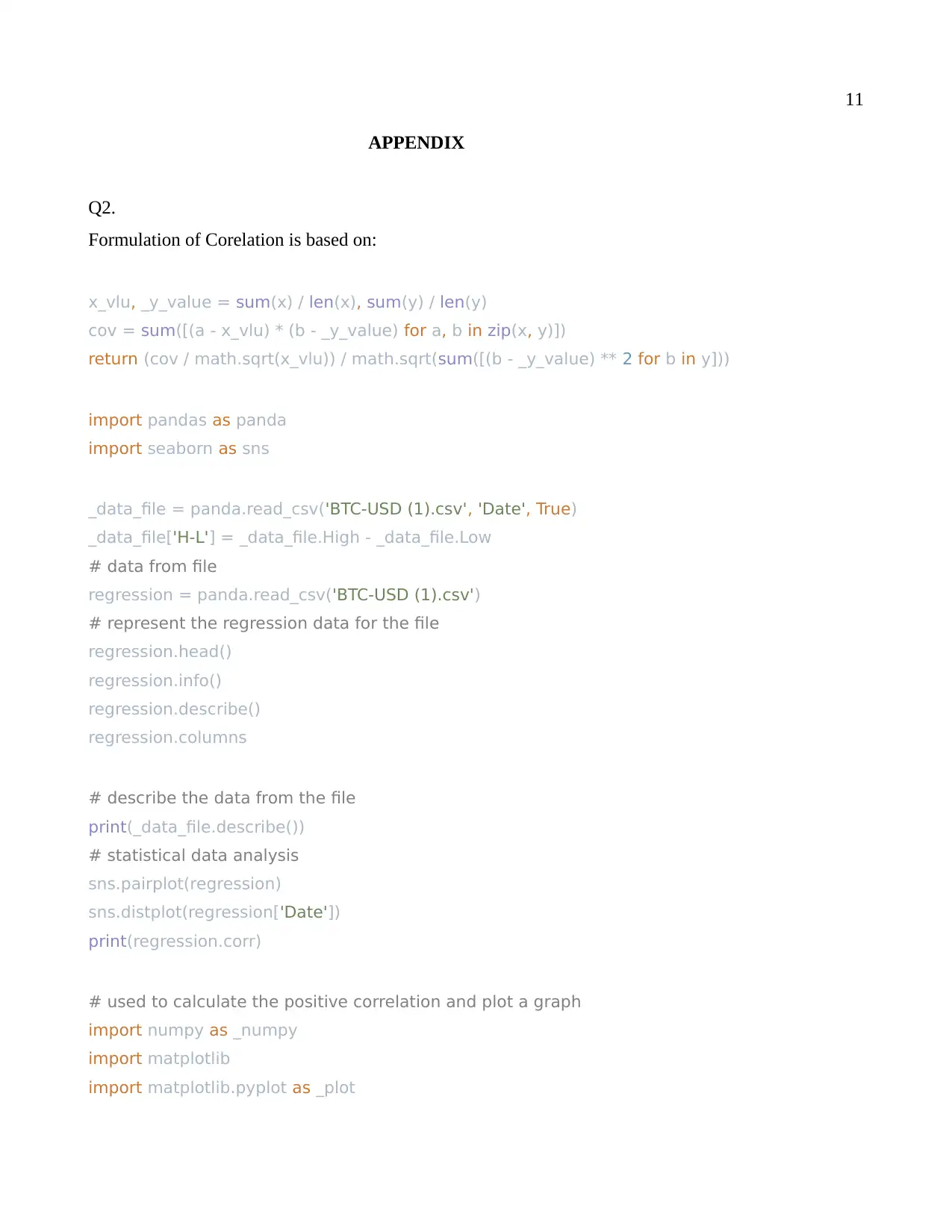
11
APPENDIX
Q2.
Formulation of Corelation is based on:
x_vlu, _y_value = sum(x) / len(x), sum(y) / len(y)
cov = sum([(a - x_vlu) * (b - _y_value) for a, b in zip(x, y)])
return (cov / math.sqrt(x_vlu)) / math.sqrt(sum([(b - _y_value) ** 2 for b in y]))
import pandas as panda
import seaborn as sns
_data_file = panda.read_csv('BTC-USD (1).csv', 'Date', True)
_data_file['H-L'] = _data_file.High - _data_file.Low
# data from file
regression = panda.read_csv('BTC-USD (1).csv')
# represent the regression data for the file
regression.head()
regression.info()
regression.describe()
regression.columns
# describe the data from the file
print(_data_file.describe())
# statistical data analysis
sns.pairplot(regression)
sns.distplot(regression['Date'])
print(regression.corr)
# used to calculate the positive correlation and plot a graph
import numpy as _numpy
import matplotlib
import matplotlib.pyplot as _plot
APPENDIX
Q2.
Formulation of Corelation is based on:
x_vlu, _y_value = sum(x) / len(x), sum(y) / len(y)
cov = sum([(a - x_vlu) * (b - _y_value) for a, b in zip(x, y)])
return (cov / math.sqrt(x_vlu)) / math.sqrt(sum([(b - _y_value) ** 2 for b in y]))
import pandas as panda
import seaborn as sns
_data_file = panda.read_csv('BTC-USD (1).csv', 'Date', True)
_data_file['H-L'] = _data_file.High - _data_file.Low
# data from file
regression = panda.read_csv('BTC-USD (1).csv')
# represent the regression data for the file
regression.head()
regression.info()
regression.describe()
regression.columns
# describe the data from the file
print(_data_file.describe())
# statistical data analysis
sns.pairplot(regression)
sns.distplot(regression['Date'])
print(regression.corr)
# used to calculate the positive correlation and plot a graph
import numpy as _numpy
import matplotlib
import matplotlib.pyplot as _plot

12
_numpy.random.seed(1)
# seed
_value_x = _numpy.random.randint(0, 500, 10000)
# find the positive correlations with the given values
_value_y = _value_x + _numpy.random.normal(0, 100, 10000)
_numpy.corrcoef(_value_x, _value_y)
_plot.scatter(_value_x, _value_y)
_plot.show()
Q3.
import os
import pandas as pd
def assess_portfolio(_assest):
# function takes asset_allocation as the input
_tr = pd.read_csv('BTC-USD (1).csv', index_col=0)
_tr.index = pd.to_datetime(_tr.index)
fiat = 'usd'
tickers = list(set(_tr['Price']))
tickers = [ticker.lower() for ticker in tickers if ticker.lower() != fiat]
# read the columns of data from the file
column_names = ['Date', 'Open', 'High', 'Low']
_numpy.random.seed(1)
# seed
_value_x = _numpy.random.randint(0, 500, 10000)
# find the positive correlations with the given values
_value_y = _value_x + _numpy.random.normal(0, 100, 10000)
_numpy.corrcoef(_value_x, _value_y)
_plot.scatter(_value_x, _value_y)
_plot.show()
Q3.
import os
import pandas as pd
def assess_portfolio(_assest):
# function takes asset_allocation as the input
_tr = pd.read_csv('BTC-USD (1).csv', index_col=0)
_tr.index = pd.to_datetime(_tr.index)
fiat = 'usd'
tickers = list(set(_tr['Price']))
tickers = [ticker.lower() for ticker in tickers if ticker.lower() != fiat]
# read the columns of data from the file
column_names = ['Date', 'Open', 'High', 'Low']
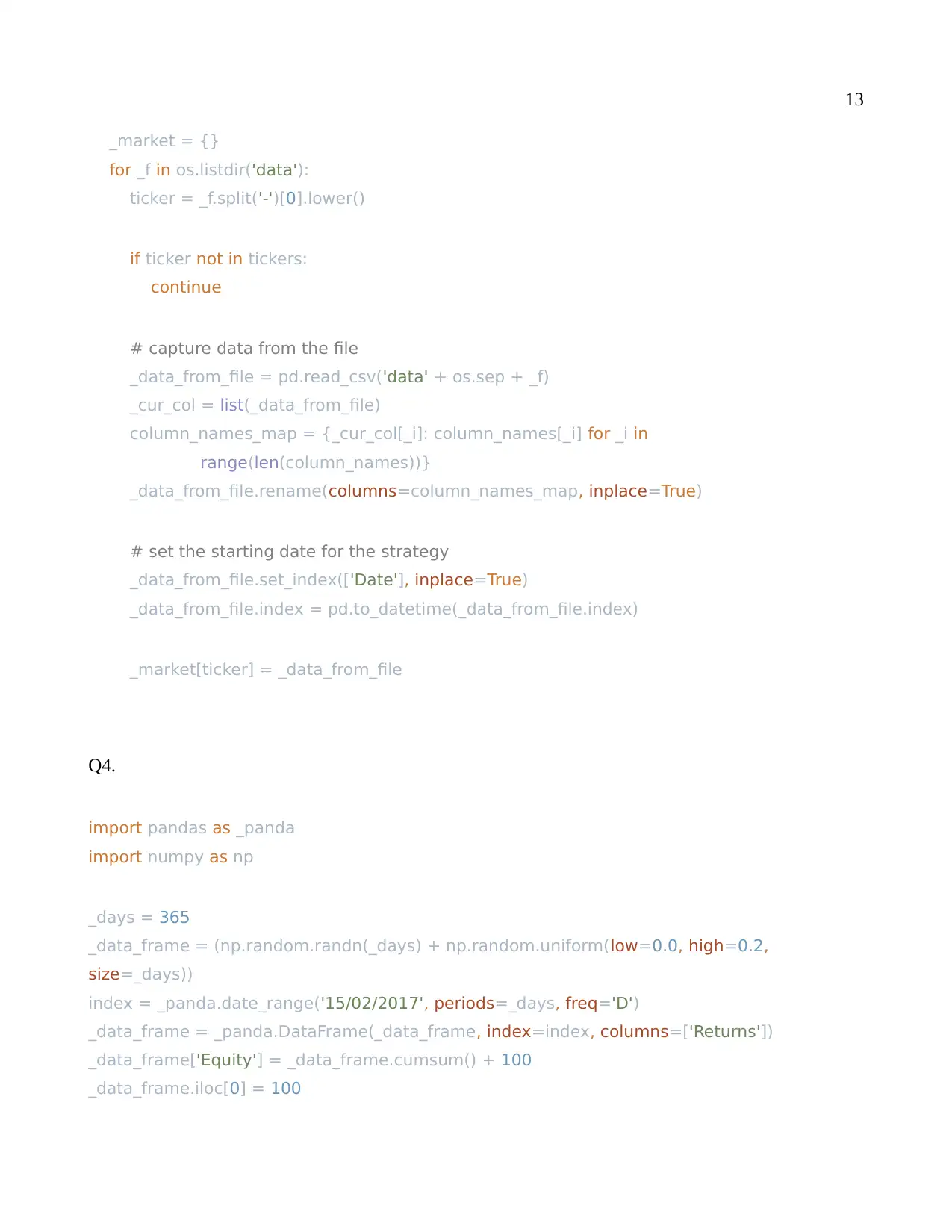
13
_market = {}
for _f in os.listdir('data'):
ticker = _f.split('-')[0].lower()
if ticker not in tickers:
continue
# capture data from the file
_data_from_file = pd.read_csv('data' + os.sep + _f)
_cur_col = list(_data_from_file)
column_names_map = {_cur_col[_i]: column_names[_i] for _i in
range(len(column_names))}
_data_from_file.rename(columns=column_names_map, inplace=True)
# set the starting date for the strategy
_data_from_file.set_index(['Date'], inplace=True)
_data_from_file.index = pd.to_datetime(_data_from_file.index)
_market[ticker] = _data_from_file
Q4.
import pandas as _panda
import numpy as np
_days = 365
_data_frame = (np.random.randn(_days) + np.random.uniform(low=0.0, high=0.2,
size=_days))
index = _panda.date_range('15/02/2017', periods=_days, freq='D')
_data_frame = _panda.DataFrame(_data_frame, index=index, columns=['Returns'])
_data_frame['Equity'] = _data_frame.cumsum() + 100
_data_frame.iloc[0] = 100
_market = {}
for _f in os.listdir('data'):
ticker = _f.split('-')[0].lower()
if ticker not in tickers:
continue
# capture data from the file
_data_from_file = pd.read_csv('data' + os.sep + _f)
_cur_col = list(_data_from_file)
column_names_map = {_cur_col[_i]: column_names[_i] for _i in
range(len(column_names))}
_data_from_file.rename(columns=column_names_map, inplace=True)
# set the starting date for the strategy
_data_from_file.set_index(['Date'], inplace=True)
_data_from_file.index = pd.to_datetime(_data_from_file.index)
_market[ticker] = _data_from_file
Q4.
import pandas as _panda
import numpy as np
_days = 365
_data_frame = (np.random.randn(_days) + np.random.uniform(low=0.0, high=0.2,
size=_days))
index = _panda.date_range('15/02/2017', periods=_days, freq='D')
_data_frame = _panda.DataFrame(_data_frame, index=index, columns=['Returns'])
_data_frame['Equity'] = _data_frame.cumsum() + 100
_data_frame.iloc[0] = 100
Paraphrase This Document
Need a fresh take? Get an instant paraphrase of this document with our AI Paraphraser

14
_performance = _data_frame['Equity'].calc_stats()
_performance.plot()
_performance = _data_frame['Equity'].calc_stats()
_performance.plot()
1 out of 14
Related Documents
Your All-in-One AI-Powered Toolkit for Academic Success.
+13062052269
info@desklib.com
Available 24*7 on WhatsApp / Email
![[object Object]](/_next/static/media/star-bottom.7253800d.svg)
Unlock your academic potential
© 2024 | Zucol Services PVT LTD | All rights reserved.





